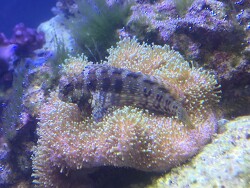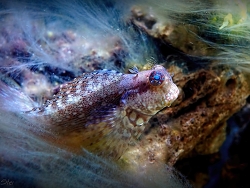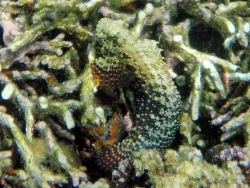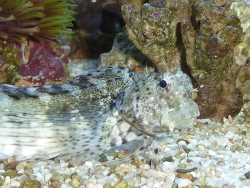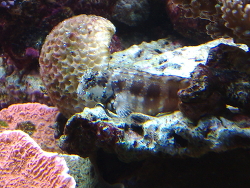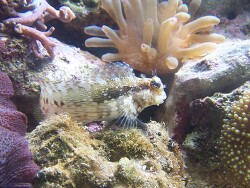Info
Salarias fasciatus (Bloch, 1786)
Blennies (Blenniidae), are a family of fish in the suborder of blennies. There are over 350 species in over 50 genera.
They are bottom dwellers, found primarily in rocky biotopes. Most species feed on algal growth and the macrozoobenthos it contains. Some species are pure plankton feeders.
Salarias fasciatus is considered to be one of the fishes that are often used in the first "algae phase". No wonder, it feels very well there, because it lives only on algae. As long as algae are present in the tank the care of Salarias is not a big problem. This only occurs when no more algae are present and only frozen food is fed. So this fish has nothing to look for in a SPS tank. It simply does not find the suitable food there by the absence of the algae. Thus it comes to a malnutrition which the fish does not survive in the long run. With a pure frozen food the belly becomes thicker and thicker with the time, because it does not correspond to the natural nutrition. You think the Salarias is doing well, but it is not.
Therefore = food specialist: feeds exclusively herbivorous in the sea. Suitable are all kinds of algae (growth algae, Nori algae, Caulerpa) Dry food only if it has a 100% algae content.
Attention with the care of Ctenochaetus Doctors. These regard the Salarias as food enemy, it comes to attacks.
Seems to us otherwise little susceptible to disease!
Never put two animals of them in one tank. This usually goes wrong, one will suffer and not survive. This only works well if you get two animals together, i.e. a pair. Even so the Salarias seems to be quite defensible, which is not seldom against similar food competitors.
Info from Stefan Ott:
This fish is kept as THE algae eater par excellence in many aquariums. Its "trademark" are the kiss-shaped lip prints on an algae-covered aquarium pane. It is also an interesting keeper in terms of behavior and appearance - but not always easy to keep. There are many reports about its gruffness towards other aquarium inhabitants, and it does not always accept replacement food. All specimens I kept accepted frozen and dry food willingly.
Info from Stefan Ott:
This fish is kept as THE algae eater par excellence in many aquariums. Its "trademark" are the kiss-shaped lip prints on an algae-covered aquarium pane. It is also an interesting keeper in terms of behavior and appearance - but not always easy to keep. There are many reports about its gruffness towards other aquarium inhabitants, and it does not always accept replacement food. All specimens I kept accepted frozen and dry food willingly.
A socialization/pair keeping has not succeeded so far - even in the 2000 liter tank the animals fight each other until the end, probably they claim a very large territory for food.
Synonyms:
Blennius fasciatus Bloch, 1786 (synonym)
Salarias fascitus (Bloch, 1786) (misspelling)
Salarias quadripennis Cuvier, 1816 (synonym)
Classification:
Biota > Animalia (Kingdom) > Chordata (Phylum) > Vertebrata (Subphylum) > Gnathostomata (Superclass) > Unreviewed: Pisces (Superclass) > Actinopterygii (Class) > Perciformes (Order) > Blennioidei (Suborder) > Blenniidae (Family) > Salariinae (Subfamily) > Salarias (Genus) > Salarias fasciatus (Species)
Jumping guard
A jumping guard prevents (nocturnal) fish from jumping out.
Wrasses, blennies, hawkfishs and gobies jump out of an unprotected tank in fright if their night rest is disturbed, unfortunately these jumpers are found dried up in the morning on carpets, glass edges or later behind the tank.
https://www.korallenriff.de/en/article/1925_5_Jump_Protection_Solutions_for_Fish_in_the_Aquarium__5_Net_Covers.html
A small night light also helps, as it provides the fish with a means of orientation in the dark!
Blennies (Blenniidae), are a family of fish in the suborder of blennies. There are over 350 species in over 50 genera.
They are bottom dwellers, found primarily in rocky biotopes. Most species feed on algal growth and the macrozoobenthos it contains. Some species are pure plankton feeders.
Salarias fasciatus is considered to be one of the fishes that are often used in the first "algae phase". No wonder, it feels very well there, because it lives only on algae. As long as algae are present in the tank the care of Salarias is not a big problem. This only occurs when no more algae are present and only frozen food is fed. So this fish has nothing to look for in a SPS tank. It simply does not find the suitable food there by the absence of the algae. Thus it comes to a malnutrition which the fish does not survive in the long run. With a pure frozen food the belly becomes thicker and thicker with the time, because it does not correspond to the natural nutrition. You think the Salarias is doing well, but it is not.
Therefore = food specialist: feeds exclusively herbivorous in the sea. Suitable are all kinds of algae (growth algae, Nori algae, Caulerpa) Dry food only if it has a 100% algae content.
Attention with the care of Ctenochaetus Doctors. These regard the Salarias as food enemy, it comes to attacks.
Seems to us otherwise little susceptible to disease!
Never put two animals of them in one tank. This usually goes wrong, one will suffer and not survive. This only works well if you get two animals together, i.e. a pair. Even so the Salarias seems to be quite defensible, which is not seldom against similar food competitors.
Info from Stefan Ott:
This fish is kept as THE algae eater par excellence in many aquariums. Its "trademark" are the kiss-shaped lip prints on an algae-covered aquarium pane. It is also an interesting keeper in terms of behavior and appearance - but not always easy to keep. There are many reports about its gruffness towards other aquarium inhabitants, and it does not always accept replacement food. All specimens I kept accepted frozen and dry food willingly.
Info from Stefan Ott:
This fish is kept as THE algae eater par excellence in many aquariums. Its "trademark" are the kiss-shaped lip prints on an algae-covered aquarium pane. It is also an interesting keeper in terms of behavior and appearance - but not always easy to keep. There are many reports about its gruffness towards other aquarium inhabitants, and it does not always accept replacement food. All specimens I kept accepted frozen and dry food willingly.
A socialization/pair keeping has not succeeded so far - even in the 2000 liter tank the animals fight each other until the end, probably they claim a very large territory for food.
Synonyms:
Blennius fasciatus Bloch, 1786 (synonym)
Salarias fascitus (Bloch, 1786) (misspelling)
Salarias quadripennis Cuvier, 1816 (synonym)
Classification:
Biota > Animalia (Kingdom) > Chordata (Phylum) > Vertebrata (Subphylum) > Gnathostomata (Superclass) > Unreviewed: Pisces (Superclass) > Actinopterygii (Class) > Perciformes (Order) > Blennioidei (Suborder) > Blenniidae (Family) > Salariinae (Subfamily) > Salarias (Genus) > Salarias fasciatus (Species)
Jumping guard
A jumping guard prevents (nocturnal) fish from jumping out.
Wrasses, blennies, hawkfishs and gobies jump out of an unprotected tank in fright if their night rest is disturbed, unfortunately these jumpers are found dried up in the morning on carpets, glass edges or later behind the tank.
https://www.korallenriff.de/en/article/1925_5_Jump_Protection_Solutions_for_Fish_in_the_Aquarium__5_Net_Covers.html
A small night light also helps, as it provides the fish with a means of orientation in the dark!







 Chrisse
Chrisse











